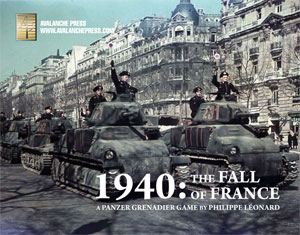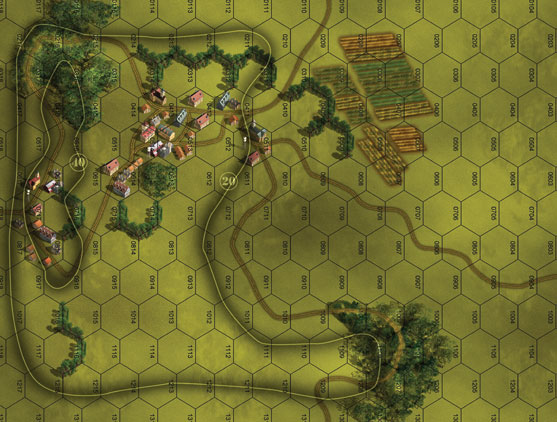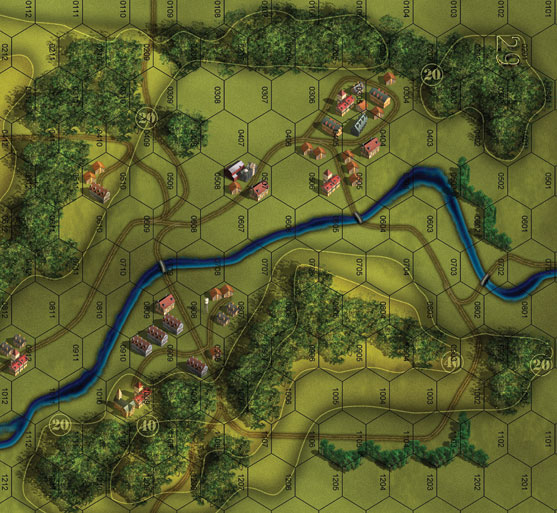| Mapping 1940: The Fall of France
By Philippe Leonard
November 2019
 When I undertook to design a Panzer Grenadier game for the German invasion of France in 1940, I did not entirely realize the extent of the task. The truth is that I had been burned out on World War II tactical games for a while, having played way too much of another tactical game. But my obsession for history won out and got me corresponding with Avalanche Press on the subject, and Mike Bennighof replied that I would need to send him “50 scenarios and eight tastefully done mapboards.” When I undertook to design a Panzer Grenadier game for the German invasion of France in 1940, I did not entirely realize the extent of the task. The truth is that I had been burned out on World War II tactical games for a while, having played way too much of another tactical game. But my obsession for history won out and got me corresponding with Avalanche Press on the subject, and Mike Bennighof replied that I would need to send him “50 scenarios and eight tastefully done mapboards.”
“Errr ... do you mean 50 or 15?”
Doing the same job for another well-known game company would imply just a few sets of scenarios covering a handful of engagements, but 50 seemed huge! Nevertheless, I accepted the challenge because I own a large library on the subject and because the quantity and quality of historical research regarding France 1940 has improved considerably over the past several years.
I began with a list of obvious locations for scenarios: Abbeville, Crehen-Merdorp, Gembloux, Stonne, Dinant, Sedan, Dunkirk. Then I put together a list of units that were must-haves to make the scenarios enjoyable: Somua S-35 and B1-bis tanks, 25mm AT guns and Panhard armored cars. With those two lists in front of me, the first scenario that took shape in my mind was “First Armor Clash, 12 May 1940, Crehen, Belgium.”
I began by drawing a map that fits the real terrain around Crehen. The result (which would eventually become Board 28) was a map with towns that look quite different from the standard hex-cluster towns on PG mapboards. Most of the fast growing villages in Europe include rowhouses aligned with the main roads, and Board 28 is representative of this. All terrain features are correct for the Crehen area, except for the hills which I added for use in other scenarios. It was a pretty straightforward start made easier by an original scale map dating back to the 1930s.

The second batch of scenarios I designed revolved around Abbeville, where De Gaulle’s famous 4th DCR counterattacked the German south flank. Board 26 accurately represents some of the terrain southwest of Abbeville: the villages are Bienfay (low left), Villers (low right), Yonval (top left), Mesnil-trois-fetus (0605) and the naked high hill on north-east is the dreaded Mont Caubert. This region of France is not far from Normandy, and hedgerows are therefore common. The swamp line west of Mont Caubert was added later to simulate marshes, parts of brooks and small river.

Board 27 was originally modeled on terrain near Abbeville, but eventually became the centrepiece of the scenarios taking place at Stonne. The main feature that made it work for those scenarios is the hilltop village surrounded by steep slopes.

Next up for mapping was the usually sleepy Belgian city of Gembloux, which saw some of the most furious fighting of the whole campaign. The terrain around it is unique: a large, slowly undulating plateau with a dense road network and isolated patches of woods, and big ancient farms dotting the landscape. Board 32 was designed using scale maps and drawings and actually depicts the area between Gembloux in the south and the village of Ernage in the north:

One important non-standard terrain feature that had to be acknowledged in scenarios around Gembloux, Flanders and Dunkirk were sunken railroads. We dealt with this by including Rail markers. Scenario special rules indicate whether specific roads are actually railroads, and then instruct players to place Rail markers in hexes that have sunken railroads.
Next up was Rommel’s crossing of the Meuse. Every "normal" wargamer — if such people exist — would instantly think of Rommel when thinking of France in 1940, and the whole business of crossing the Meuse under fire is a thrilling experience no PG player would want to miss. The tactical situation is a feast: two rival Panzer divisions — the 5th and 7th — competing in heavily wooded terrain to be the first to reach the Meuse. In front of them, French cavalry units are fleeing in disarray but still trying to gain time by delaying the German advance (see Scenario Seven: Race to the Meuse). The 5th Panzer Division won the race by reaching Yvoir, but the bridge there was blown up at the last second by some Belgian engineers. During the following night, a recon unit from 5th Panzer found a kind of narrow sluice across the river in Houx, and Germans began pouring onto the western bank. The following morning, Rommel launched an all-out assault (See Scenario Eight: Rommel Crosses the Meuse).
Designing river boards for these scenarios was quite easy. Board 29 was directly inspired by the area around Houx. The high wooded banks of the river, Anhée in the north, Houx in center-east not far from the island and the château de Senennes (0510).

The idea of simulating the whole of Rommel’s assault on the Meuse on tactical level had such an appeal that I couldn’t resist drawing a second river board featuring the city of Dinant south of Houx. This is Board 30, showing a river with high wooded banks again and a rather large city to the south.

The two river boards connect in order to represent the full river line between Anhée and Dinant. These two boards are also perfect for engagements in the Belgian or French Ardennes and the Vosges mountains, and are used in numerous scenarios. The river scenarios are actually the heart of the game, because the speed of the German campaign forced the Allies to take quick shelter behind every water line they could find until they had their backs to the sea.
The remaining two boards are generics that depict small scattered villages, fields and large areas of woods. All together, the boards do a good job of representing all the terrain types the opposing sides had to deal with during the invasion of France. We hope you enjoy them!
Order 1940: The Fall of France right now.
Sign up for our newsletter right here. Your info will never be sold or transferred; we'll just use it to update you on new games and new offers.
|
